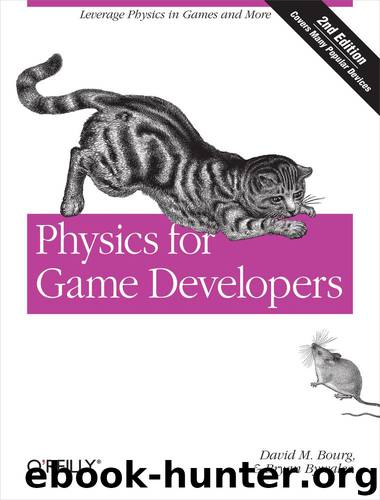Physics for Game Developers by David M Bourg & Bryan Bywalec

Author:David M Bourg & Bryan Bywalec
Language: eng
Format: epub
Tags: COMPUTERS / Programming / General
ISBN: 9781449302603
Publisher: O’Reilly Media
Published: 2013-04-09T16:00:00+00:00
Force Effectors
Force effectors apply direct or indirect force on the objects in your simulations. Your physics engine may include several. For example, if your engine allows users to move objects around with the mouse, then you’ll need some virtualization of the force applied by the user via the mouse or a finger on a touch screen. This is an example of a direct force. Another direct force effector could be a virtual jet engine. If you associate that virtual engine, which produces some thrust force, with some object, then the associated object will behave as though it were pushed around by the jet.
Some examples of indirect force effectors include gravity and wind. Gravity applies force on objects by virtue of their mass, but it is typically modeled as body acceleration and not an explicit force. Wind can be viewed as exerting a pressure force on an object, and that force will be a function of the object’s size and drag coefficients.
You can imagine all sorts of force effectors, from ones similar to those just described to perhaps some otherworldly ones. Whatever you imagine, you must remember that a force has magnitude, direction, and some central point of application. If you put a jet engine on the side of a box, the box will not only translate but will spin as well. Wind creates a force that has a center of pressure, which is the point through which you can assume the total wind force acts. The direction of the force and point of application are important for capturing both translation and rotation. As an example, consider the hovercraft we modeled in Chapter 9 that included two bow thrusters for steering and a propeller for forward motion. Each of these direct force effectors—the bow thrusters and the propeller—is applied at specific locations on the hovercraft. The bow thrusters are located toward the bow and point sideways in order to create spin, thus allowing some steering. The propeller is located on the center line of the hovercraft, which passes through the hovercraft’s center of gravity so that it does not create spin and instead simply pushes the craft forward. There’s another force effector in that model—aerodynamic drag, which is an indirect force effector. The drag force is applied at a point aft of the center of gravity so that it creates some torque, or moment, which in this model helps keep the hovercraft pointed straight; it provides some directional stability.
Whatever force effectors you contrive, they all must be aggregated for each object and dealt with in your numerical integrator. Thus, your integrator must have some means of accessing all the force effector information required to accurately simulate their effect on each associated object.
Download
This site does not store any files on its server. We only index and link to content provided by other sites. Please contact the content providers to delete copyright contents if any and email us, we'll remove relevant links or contents immediately.
The Complete Stick Figure Physics Tutorials by Allen Sarah(7307)
Secrets of Antigravity Propulsion: Tesla, UFOs, and Classified Aerospace Technology by Ph.D. Paul A. Laviolette(5309)
Thing Explainer by Randall Munroe(3877)
The River of Consciousness by Oliver Sacks(3538)
The Order of Time by Carlo Rovelli(3145)
How To by Randall Munroe(3033)
A Brief History of Time by Stephen Hawking(2960)
I Live in the Future & Here's How It Works by Nick Bilton(2935)
The Great Unknown by Marcus du Sautoy(2646)
What If?: Serious Scientific Answers to Absurd Hypothetical Questions by Randall Munroe(2637)
Midnight in Chernobyl by Adam Higginbotham(2483)
Blockchain: Ultimate Step By Step Guide To Understanding Blockchain Technology, Bitcoin Creation, and the future of Money (Novice to Expert) by Keizer Söze(2445)
Networks: An Introduction by Newman Mark(2360)
The Meaning of it All by Richard Feynman(2300)
Easy Electronics by Charles Platt(2281)
The Tao of Physics by Fritjof Capra(2229)
Midnight in Chernobyl: The Untold Story of the World's Greatest Nuclear Disaster by Adam Higginbotham(2177)
When by Daniel H Pink(2082)
Introducing Relativity by Bruce Bassett(2076)
